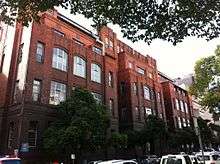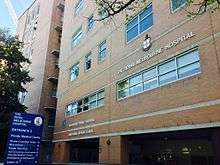Stephenson and Turner
Originally known as Stephenson and Meldrum (1921–1937), Stephenson and Turner (1938–1995) were Australian architects in the 1930s that pioneered the modernist movement in Australian architecture, specialising in hospital and institutional design during the interwar period. As hospitals were among the first large scale buildings to adopt the new modern aesthetic, the modern Australian hospital played an important role in the development of Modernism in Australian architecture.
The directors were Arthur Stephenson, Percy Meldrum and Donald Turner.
Arthur George Stephenson
Sir Arthur George Stephenson (1890–1967), architect, born in 1890 at Box Hill, Victoria. In 1907 Stephenson worked for Swansson Brothers while studying construction at the Working Men’s College. He joined the Australian Imperial Force in 1915 as a lieutenant, promoted to captain and awarded the Military Cross. After WWI, Stephenson remained in London and studied at the Architectural Association School (AA) and joined the Royal Institute of British Architects (RIBA) in 1920. He returned to Melbourne and established Stephenson & Meldrum in 1921.
Stephenson was largely responsible for the firm’s direction to specialize in hospital and industrial architecture. He also lectured, wrote widely and was a member of numerous committees, including the International Hospitals Federation, the Hospital Advisory Council (Melbourne) and a trustee of the National Museum of Victoria.[1]:80 In 1954 Stephenson was knighted for services to architecture and was the first Australian to receive a RIBA Gold Medal in 1964. The Royal Australian Institute of Architects (RAIA) awarded him a Gold Medal in 1963 and was made honorary fellow by The American Institute of Architects in 1964.
Percy Meldrum
Percy Hayman Meldrum (1887–1968), architect, born in 1887 at Casterton, Victoria and educated at Ballarat College. In 1907 he studied architecture and articled to Melbourne Architect A. A. Fritsch from 1907 until 1913, where he won the Royal Victorian Institute of Architects Bronze Medal.[1]:81 In 1913 Meldrum travelled to Chicago and admired the architecture of Frank Lloyd Wright. Then travelled to England in 1914 and worked with the War Office designing aircraft hangars. In 1919 Meldrum joined the AA, where he met and taught Arthur Stephenson and Donald Turner.[1]:81 A fine draftsman and watercolorist, Meldrum was the artistic director and collaborated with some of Melbourne’s prominent artists, including Napier Waller, whose mosaic featured on the façade of the Newspaper House in Melbourne (1933). Stephenson and Meldrum’s partnership ended in 1937, with Meldrum moving on to practice with Arthur Noad, to form Meldrum and Noad.
Donald Turner
Donald Turner (1895–1964), architect, was born at Maitland, NSW. He began his architectural career as a student with Ross & Rowe in 1912.[1]:82 In 1915 he enlisted in the First All and served as captain until 1919 with the Field Artillery in Egypt and France. After WWI he also studied at the AA in London where he met Arthur Stephenson and Percy Meldrum. Turner joined the RIBA in 1921 and was appointed assistant architect for the Imperial War Graves Commission. Returning to Melbourne in 1924, he joined Stephenson and Meldrum and was promoted to director in 1936. With Meldrum’s departure in 1937 the firm’s name changed to become Stephenson and Turner in 1938.
Projects
Hospitals

Many of the major hospitals built in Australia from the 1920s to the 1960s reflected Stephenson’s influence.[2] Robin Boyd wrote in his book, Victorian Modern (1947), “hospitals gave modern architecture in Australia its first big break”.[3] The early 20th century saw advancements in medical technology and treatments, which transformed hospitals into a symbol of modern and healthy society.[4] Stephenson took full advantage of this and traveled to America in 1927 to research the most modern developments in hospital design and equipment. The firm’s first major hospital commission, St Vincent’s Hospital in East Melbourne (1932), although a restrained blocky brick building applied Stephenson’s approach to efficient planning to accommodate modern medical technology.
It wasn’t until after Stephenson’s research trip in 1932–33 to continental Europe did hospital design in Australia drastically change. Stephenson was inspired by European Modernism, particularly Bijvoet and Duiker’s Zonnestraal Sanatorium (1928) in the Netherlands, and the Paimio Sanatorium (1929–33) in Finland by Alvar Aalto, which Stephenson described as a way “to express in the simplest form the function of the building in the most appropriate materials".[4] It is in the design of the Mercy Hospital (1934) that Stephenson’s new approach to hospital design becomes apparent: a six level reinforced concrete building with streamlined, cantilevered balconies and large sweeping windows that allowed for sun control and the wellbeing of patients. The efficiency of the design was described by Professor John Freeland as “clean-cut with the precision of a machine”.[5]

The success of the Mercy was followed by a succession of hospital commissions in Australia for Stephenson and Meldrum (Turner from 1937), most featuring long sweeping horizontal balconies with curved corners on a body of cream brick, a streamlined functionist idiom. The Freemason’s Hospital (1936) in East Melbourne was followed by the United Dental Hospital (1940) in Sydney, and a Pathology Block at the Royal Women's Hospital in Melbourne in 1941. In 1936 they began designing the new The Royal Melbourne Hospital in Parkville, completed in 1942, which served as an American military hospital during WWII (returned to civiliand use in 1944). The front façade design departed from the sweeping horizontality that Stephenson’s hospitals were known for; instead they opted for a simple and pared back International Style (though the rear facade did include their signature sweeping white horizontal balconies).
While work on the Royal Melbourne Hospital was underway, they also designed the King Geoge V Hospital for Mothers and Babies in Sydney (1939-41), and the Concord Repatriation Hospital, completed in 1942, which both feature the sweeping horizontal balconies on the front facades.
World Fairs
The Australian pavilions at the World Fair in Paris (1936) and at the Wellington Exhibition, New Zealand (1939), were built by the firm. New York honoured Stephenson with citizenship for his work on its 1939 World Fair.[2]
Commercial works
Stephenson and Turner were closely involved in the post-war manufacturing revolution in Australia,[2] designing plants for Holden – General Motors plant in Dandenong, Ford, BHP, Fibremakers as well as Australia’s first experimental nuclear reactor in Lucas Heights for the Atomic Energy Commission. They applied the same rigorous approach to researching and engaging with state of the art technologies and methods of manufacturing. Their design for the Holden Factory complex (1954–56) in Dandenong featured a completely functional curtain wall system.
As well as major buildings in every capital city in Australia, in New Zealand and a hospital in Basra, Iraq, Stephenson and Turner grew to become the largest Australian architecture firm at its time with 300 – 400 staff at its peak.[1] They opened offices internationally in Singapore (1949), New Zealand (1956) and Hong Kong. Stephenson and Turner were one of the many architectural firms that were hit hard by the global economic downturn during the mid 1980s and merged with John Castles to become Castles, Stephenson and Turner in 1995. Since 2000, all Australian operations have closed down, with offices operating in New Zealand since 1956.
Today Stephenson & Turner operates out of 5 bases in New Zealand, specialising in social infrastructure buildings and carrying on its heritage in healthcare architecture.
Buildings List
- Collins Court Office Building, Little Collins Street, Melbourne, Victoria, 1920–1922
- Melbourne Town Hall (renovations to main hall), Swanston Street, Melbourne, Victoria, 1925–1927
- Members Pavilion, Melbourne Cricket Ground, East Melbourne, Victoria, 1927
- Kangaroo Ground War Memorial Tower, Kangaroo Ground, Victoria, 1927
- Castlemaine Art Museum, Lyttleton Street, Castlemaine, Victoria, 1931
- Lord Somers Camp, Somers, Victoria, 1931
- St Vincent's Hospital, Fitzroy, Victoria, 1930–1934
- Newspaper House, Collins Street, Melbourne, 1932
- Mercy Hospital, East Melbourne, Victoria, 1934
- Bethsada Hospital, Richmond, Victoria, 1936
- United Dental Hospital, Surrey Hills, New South Wales, 1936–1940
- Freemasons Hospital, East Melbourne, Victoria, 1936
- Royal Melbourne Hospital, Parkville, Victoria, 1936–1942 (altered)
- Gloucester House, Royal Prince Alfred Hospital, Darlinghurst, New South Wales, 1936
- Australian Pavilion, Paris Exposition, Paris, France, 1937
- Victorian Railways Commission, Spirit of Progress Train, 1937
- English Scottish and Australian Bank (now ANZ), Royal Branch, Melbourne, Victoria, 1938–1942
- Australian Pavilion, New Yorks World’s Fair, New York, United States, 1939–1940
- Victorian Government Tourist Bureau, Melbourne, Victoria, 1939
- King George V Hospital for Mothers and Babies, Sydney, New South Wales, 1939–1941
- Concord Repatriation Hospital (a.k.a. Yaralla Military Hospital), Concord, New South Wales, 1940– 1942
- King George V Pathological Block, Royal Women's Hospital, Melbourne, 1941 (demolished)
- Main Ward Block, Alfred Hospital, Prahran, Victoria, 1960s
- General Motors Holden Complex, (Dandenong, Fishermen’s Bend, and Lang Lang) Victoria, (Pagewood) New South Wales, (Strathpine) Queensland, and (Trentham) New Zealand, 1952–1964
- Australian Atomic Energy Commission Research Establishment, Lucas Heights, New South Wales, 1954– 1962
- Royal Children's Hospital, Parkville, Melbourne, 1958–1963 (demolished)
- Fibremakers Factory, Bayswater, Victoria, 1958– 1968
- Southern Base Teaching Hospital, Basrah, Iraq, 1958–1982
- Royal North Shore Hospital, Sydney, New South Wales, 1961–1971
- Colonial Mutual Life Assurance Society Ltd Building, Melbourne, Victoria, 1963
- United Christian Hospital Extension (Staff Quarter), N.K.I.L. 6014, Hong Kong, 1986
Awards
1941 Sulman Award, King George V Hospital, Sydney.
1941 RVIA Street Architectural Medal, King George V Jubilee Pathological Building, Royal Women’s Hospital, Melbourne.
1946 Sulman Award, Yaralla Military Hospital, Concord.
References
- 1 2 3 4 5 Philip Goad and others: Australian Modern: The Architecture of Stephenson and Turner, The Miegunyah Press and the State Library of Victoria, 2004.
- 1 2 3 Fisher, J.D., Australian Dictionary of Biography: Stephenson, Sir Arthur George (1890–1967), [adb.anu.edu.au/biography/stephenson-sir-arthur-george-8646)].
- ↑ Shaw, Sir Arthur Stephenson: Australian Architect, 85.
- 1 2 Julie Willis, Machines for healing, Architecture Australia, July/August 2002, 46.
- ↑ John Shaw, Sir Arthur Stephenson: Australian Architect, The Stephenson & Turner Sydney/Hong Kong Group, 1987, 86.
- Fisher, J. D. (1990). "Stephenson, Sir Arthur George (1890–1967)". Australian Dictionary of Biography. 12. Canberra: Australian National University. Retrieved 11 September 2015.
- Australian Institute of Architects, Nationally significant 20th century architecture: Mercy Hospital (former), http://www.architecture.com.au/docs/default-source/vic-notable-buildings/mercy-hospital-(former).pdf?sfvrsn=0
- East Melbourne Historical Society, East Melbourne Walk, emhs.org.au/catalogue/emvf0131
- Julie Willis, Machines for healing, Architecture Australia, July/August 2002.
- Philip Goad and others, Australian Modern: the architecture of Stephenson and Turner, the Miegunyah Press and the State Library of Victoria, 2004.
- John Shaw, Sir Arthur Stephenson: Australian Architect, The Stephenson & Turner Sydney/Hong Kong Group, 1987, 86.